As a mushroom cultivator, one of the biggest concerns is the risk of contamination in mycelium fruit. Contamination can have a detrimental impact on the growth and quality of your mushrooms, affecting your overall yield and success. It is crucial to understand the factors that contribute to contamination and how to prevent it in order to ensure healthy and thriving mycelium.
Throughout this article, we will explore the various aspects of mycelium fruit contamination, including the signs to look out for, common types of contaminations, and effective prevention techniques. By gaining this knowledge, you will be equipped with the necessary tools to safeguard your mushroom cultivation and optimize your results.
Key Takeaways:
- Contamination can adversely affect the growth and quality of mycelium fruit.
- Factors that contribute to contamination include poor sanitation, inadequate sterilization, and exposure to airborne contaminants.
- Signs of contamination include unusual colors or odors, slimy textures, and the presence of molds or bacteria.
- Wet spot contamination can lead to poor mushroom development and compromised yield.
- Implementing proper contamination control measures, such as maintaining a clean environment and using quality sterilization techniques, is crucial.
Factors that Contribute to Contamination
When it comes to mushroom cultivation, the health and safety of mycelium fruit should be a top priority. To ensure successful growth, it is important to understand the factors that contribute to contamination and take necessary precautions to prevent it. Here, we will explore some of the key factors that can lead to contaminated mushroom cultivation.
Poor Sanitation Practices
One of the primary culprits behind contamination is poor sanitation practices. Failing to maintain a clean and sterile environment can introduce harmful microorganisms and spores that can affect the health of the mycelium. It is essential to regularly clean and disinfect all equipment, work surfaces, and containers involved in the cultivation process to minimize the risk of contamination.
Inadequate Substrate Sterilization
Another factor that can contribute to contamination is insufficient sterilization of substrates. The substrate serves as a nutrient-rich medium for mycelium growth, but it can also harbor potential contaminants. Proper sterilization techniques, such as steam or heat treatment, are necessary to eliminate any unwanted microorganisms and provide a clean environment for healthy mycelium development.
Airborne Contaminants and Pest Infestations
Contamination can also occur through exposure to airborne contaminants or the presence of pests and insects. Airborne spores and particles can settle on the mycelium, leading to unwanted growth. Additionally, pests and insects can introduce harmful microorganisms or damage the mycelium, making it more susceptible to contamination. Ensuring proper air filtration and implementing pest control measures are crucial in preventing contamination.
| Factors | Impact |
|---|---|
| Poor Sanitation Practices | Introduces harmful microorganisms and spores |
| Inadequate Substrate Sterilization | Allows potential contaminants to thrive |
| Airborne Contaminants and Pest Infestations | Exposes mycelium to unwanted growth and harmful microorganisms |
By understanding and addressing these factors that contribute to contamination, cultivators can minimize the risk and ensure healthier and higher-quality mycelium fruit.
Signs of Contamination in Mycelium
As a cultivator, it is essential to be able to recognize the signs of contamination in mycelium to ensure the quality assurance and prevent further spread. By conducting regular visual inspections and monitoring growth patterns, you can detect contamination early and take necessary steps to mitigate its impact. Here are some common indicators to look out for:
- Unusual colors or odors: Contaminated mycelium may exhibit colors other than the typical white or off-white, such as green, yellow, or blue. Similarly, abnormal or foul odors can suggest the presence of contaminants.
- Slimy or gel-like textures: If the mycelium appears slimy or has a gel-like consistency, it may indicate contamination. Healthy mycelium should have a cotton-like texture.
- Sectoring or lack of uniform growth: Contaminated mycelium may exhibit uneven growth patterns, with certain sectors appearing stunted or lagging behind. In contrast, healthy mycelium should show uniform and consistent growth.
- Presence of molds or bacteria: The presence of visible molds, fuzzy growths, or bacterial colonies on the mycelium are clear indications of contamination. These contaminants can inhibit proper fruiting and compromise the overall quality of the mycelium.
By being attentive to these signs, you can identify contamination early on and take appropriate measures to prevent its spread. Promptly removing contaminated mycelium and implementing stricter sanitation practices can help maintain the integrity of your mycelium cultures and ensure successful cultivation.
| Signs of Contamination | Description |
|---|---|
| Unusual colors or odors | Contaminated mycelium may exhibit colors other than the typical white or off-white, such as green, yellow, or blue. Similarly, abnormal or foul odors can suggest the presence of contaminants. |
| Slimy or gel-like textures | If the mycelium appears slimy or has a gel-like consistency, it may indicate contamination. Healthy mycelium should have a cotton-like texture. |
| Sectoring or lack of uniform growth | Contaminated mycelium may exhibit uneven growth patterns, with certain sectors appearing stunted or lagging behind. In contrast, healthy mycelium should show uniform and consistent growth. |
| Presence of molds or bacteria | The presence of visible molds, fuzzy growths, or bacterial colonies on the mycelium are clear indications of contamination. These contaminants can inhibit proper fruiting and compromise the overall quality of the mycelium. |
Being able to identify signs of contamination is crucial for maintaining the health and quality of mycelium. By conducting regular inspections and following contamination prevention practices, you can ensure that your mycelium cultures remain free from harmful contaminants, maximizing your chances of successful mushroom cultivation.
Impact of Wet Spot Contamination
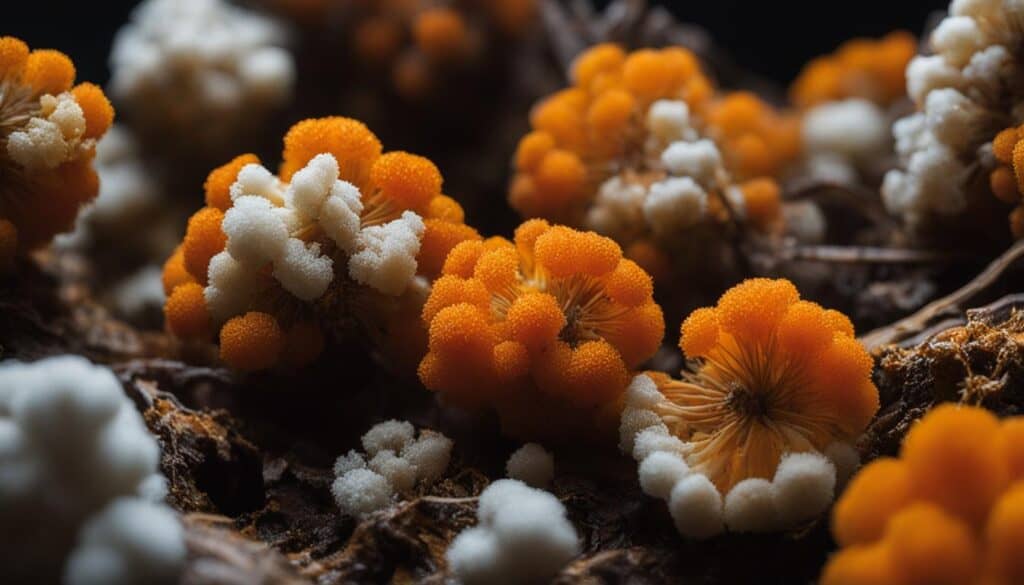
Wet spot contamination can have detrimental effects on the growth and quality of mycelium fruit. This type of contamination, often caused by bacteria like Bacillus, is characterized by soggy or wet areas in the substrate, the presence of brown or yellowish goo, and stalled or non-growth in certain parts. The consequences of wet spot contamination include poor mushroom development and compromised yield. It is crucial to address this issue promptly to prevent further damage to the mycelium.
Table: Effects of Wet Spot Contamination on Mycelium Fruit
| Effects | Description |
|---|---|
| Poor Growth | Wet spots in the substrate hinder mycelium expansion and compromise overall growth. |
| Limited Fruiting | The presence of wet spots can inhibit the formation of mushroom fruiting bodies, leading to a reduced yield. |
| Uneven Development | Wet spot contamination often results in sectoring or non-uniform growth patterns, causing irregular fruiting. |
| Lower Quality | Mycelium fruit affected by wet spot contamination may have decreased flavor, texture, and nutritional value. |
To prevent wet spot contamination, it is essential to maintain a sterile environment, practice proper sterilization techniques, and ensure adequate air filtration. Regular monitoring for signs of contamination, such as wet or slimy areas, is also crucial. If wet spot contamination is detected, immediate action should be taken to remove the affected substrate and sanitize the growing area. Adjusting environmental conditions, such as reducing humidity levels, can help prevent the recurrence of wet spot contamination in future cultivation cycles.
Methods of Contamination Control
Implementing proper contamination control measures is essential for ensuring successful mycelium fruit cultivation. By following best practices and taking necessary precautions, cultivators can minimize the risk of contamination and increase the chances of healthy and abundant mushroom growth.
Creating a Clean and Sterile Environment
One of the key steps in preventing contamination is maintaining a clean and sterile environment. This includes regularly sanitizing the cultivation area, tools, and work surfaces with a suitable disinfectant. It is also important to wear protective clothing, such as gloves and a lab coat, to prevent any external contaminants from coming into contact with the mycelium.
Using Quality Sterilization Techniques
Proper sterilization of substrates is crucial for eliminating potential contaminants. This can be achieved through various techniques, such as pressure cooking, autoclaving, or using a sterilization agent. It is important to follow the recommended sterilization process and ensure that the substrate reaches the required temperature and duration for effective sterilization.
Implementing Air Filtration
Airborne contaminants can greatly contribute to mycelium fruit contamination. To prevent this, it is advisable to use high-efficiency particulate air (HEPA) filters or equivalent air filtration systems in the cultivation area. These filters are designed to trap and remove airborne contaminants, reducing the risk of contamination and promoting a clean and safe environment for the mycelium to thrive.
| Contamination Control Measures | Benefits |
|---|---|
| Creating a clean and sterile environment | – Minimizes the introduction of external contaminants – Reduces the risk of contamination during the cultivation process |
| Using quality sterilization techniques | – Eliminates potential contaminants – Promotes a sterile substrate for mycelium growth |
| Implementing air filtration | – Filters out airborne contaminants – Maintains a clean and safe environment for mycelium cultivation |
Importance of Primary Sources for Inoculation
When it comes to mycelium cultivation, the choice of primary sources for inoculation is of utmost importance. Starting with reliable agar plates or liquid cultures obtained from reputable suppliers is key to ensuring the purity and quality of the mycelium used for expansion onto substrates. By establishing a reference library of mycelium through these primary sources, cultivators can ensure consistent and healthy growth, setting the foundation for successful mushroom cultivation.
Using primary sources from reputable suppliers guarantees the genetic integrity of the mycelium, reducing the risk of contamination and promoting optimal growth. These sources have undergone rigorous quality checks and are free from unwanted organisms that could hinder the cultivation process. With a focus on mycelium fruit cultivation best practices, starting with reliable primary sources provides cultivators with the assurance that their efforts will yield high-quality and abundant mushrooms.
Selecting the Right Primary Sources
When selecting primary sources, it is essential to choose those that align with the specific mushroom species being cultivated. Different mushroom species require specific nutrient requirements and environmental conditions to thrive. Reputable suppliers can provide expert advice on suitable primary sources based on the cultivator’s desired mushroom variety.
Furthermore, proper handling and storage of primary sources are crucial. Maintaining sterile conditions during transfer and storage prevents cross-contamination and ensures the viability of the mycelium. Cultivators must follow recommended protocols for storage, including maintaining a controlled temperature and minimizing exposure to light.
| Primary Source | Advantages | Considerations |
|---|---|---|
| Agar plates | Readily available, easy to work with | May require additional steps for expansion onto substrates |
| Liquid cultures | Can be directly used for inoculation | More prone to contamination |
By selecting the appropriate primary sources and following recommended handling and storage practices, cultivators can establish a strong foundation for successful mycelium cultivation. Starting with reliable sources sets the stage for healthy and abundant mushroom growth, ensuring the cultivation process is characterized by best practices and high-quality results.
Mycelium Expansion Procedures for Optimal Growth

Expanding mycelium onto different substrates is a crucial step in the cultivation of healthy and productive mushrooms. There are specific procedures that should be followed to ensure optimal mycelium growth and minimize the risk of contamination. Here, I will outline the best practices for expanding mycelium and highlight the importance of these procedures in achieving successful mushroom cultivation.
The expansion process begins with the transfer of small sectors of fully colonized agar cultures or the use of liquid cultures to inoculate other substrates such as grains, sawdust, or straw. This step is essential for introducing the mycelium to a new nutrient source and encouraging its growth and development. It is important to handle the mycelium cultures with care, maintaining a clean and sterile environment throughout the process to prevent contamination.
During the expansion phase, mycelium growth typically follows a sigmoid-shaped pattern. It starts with slow initial growth, followed by a period of linear growth, and eventually reaches full colonization. Monitoring the growth patterns and ensuring the appropriate environmental conditions, such as temperature and humidity, are maintained, are crucial for promoting healthy and vigorous mycelium expansion.
“Proper expansion procedures are vital for successful mycelium growth and contamination prevention. Attention to detail in handling and transferring the mycelium, along with monitoring growth patterns, can greatly contribute to the overall success of mushroom cultivation.”
By following these expansion procedures and adhering to best practices, cultivators can maximize the chances of achieving robust mycelium growth and minimize the risk of contamination. Maintaining a clean and sterile environment, handling the mycelium cultures carefully, and monitoring growth patterns are key factors in ensuring the successful expansion of mycelium onto various substrates.
| Expansion Procedures for Mycelium Growth | Benefits |
|---|---|
| Transfer small sectors of fully colonized agar cultures or use liquid cultures | Introduces mycelium to new nutrients and encourages growth |
| Maintain a clean and sterile environment throughout the expansion process | Minimizes the risk of contamination |
| Monitor mycelium growth patterns | Allows for early detection of issues and adjustments as needed |
| Ensure appropriate environmental conditions (temperature, humidity) | Promotes healthy and vigorous mycelium expansion |
Sterilization and Pasteurization Techniques
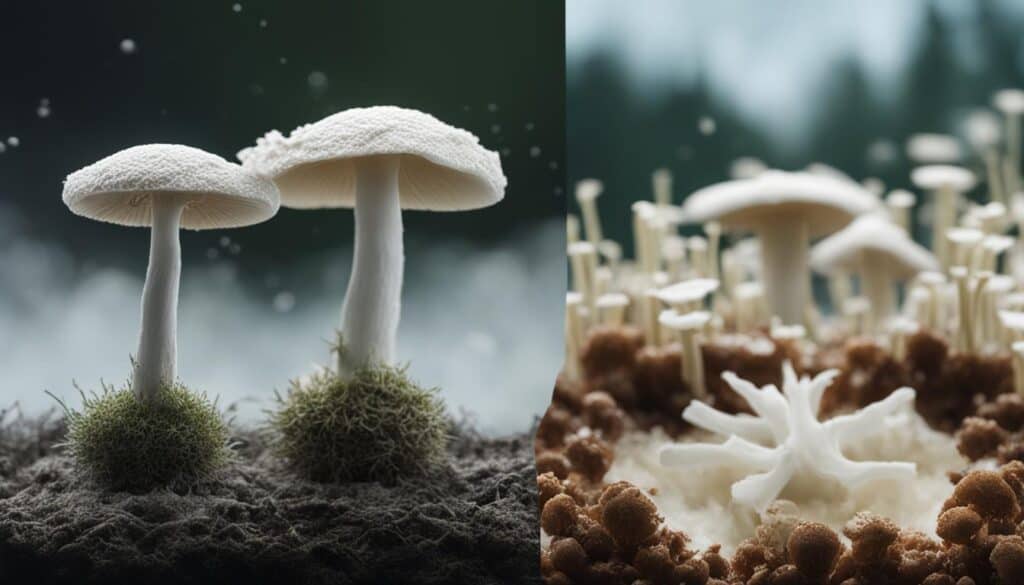
When it comes to mycelium fruit cultivation, proper sterilization and pasteurization techniques are essential for preventing contamination and ensuring a safe growing environment. These techniques play a crucial role in eliminating harmful microorganisms and spores that can compromise the health and growth of mycelium. By following best practices and implementing these techniques, cultivators can significantly reduce the risk of contamination and increase the chances of successful mushroom cultivation.
There are different methods for sterilization and pasteurization, depending on the specific needs of the cultivation process. Sterilization involves killing all microorganisms present in the substrate and equipment, while pasteurization reduces the microbial load to a safer level. Both methods require careful attention to detail and adherence to aseptic practices.
One common sterilization method is the use of a pressure cooker or autoclave. These devices generate high heat and pressure, effectively sterilizing the substrate and containers. Pasteurization, on the other hand, involves heating the substrate to a lower temperature for a longer duration to kill most microorganisms while preserving beneficial organisms.
Table: Sterilization and Pasteurization Techniques
| Technique | Purpose |
|---|---|
| Pressure cooking | Kills all microorganisms by subjecting them to high heat and pressure |
| Autoclaving | Uses steam under pressure to achieve sterilization |
| Pasteurization | Reduces the microbial load without completely sterilizing the substrate |
| Hot water bath | Immersing the substrate in hot water to kill most microorganisms |
It is important to note that sterilization and pasteurization techniques alone cannot guarantee a contamination-free environment. Proper hygiene practices must also be followed, including wearing sterile gloves, using clean tools, and working in a clean and well-ventilated area. Regular monitoring and visual inspections should be conducted to detect any signs of contamination and take immediate action to prevent its spread.
By implementing effective sterilization and pasteurization techniques, along with strict hygiene practices, cultivators can create a safe and conducive environment for mycelium fruit cultivation. These measures help minimize the risk of contamination, ensuring healthy and high-quality mushroom growth.
Common Types of Contaminations in Mushroom Cultivation
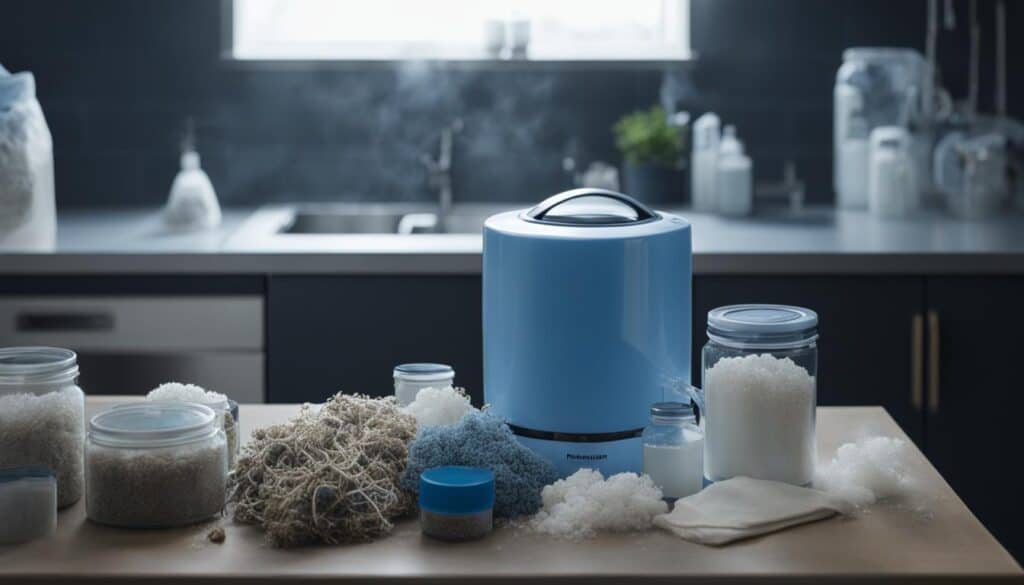
When it comes to mushroom cultivation, there are several types of contaminations that can pose a threat to the health and success of mycelium fruit. Understanding these common contaminations is essential for implementing effective prevention measures and maintaining optimal safety precautions.
Bacterial Contamination: Bacteria can infiltrate the growing environment through improper sterilization techniques, contaminated water sources, or unclean equipment. Examples of bacterial contaminations include wet spot/sour rot and bacterial blotch.
Fungal Contamination: Fungi can proliferate in the growing environment, competing with mycelium and hindering its growth. Some common examples of fungal contaminations include cobweb mold, green mold, and black mold.
Pest Infestations: Insects and mites can also pose a threat to mycelium fruit. Fungus gnats and mites are known to infest mushroom cultivation environments, potentially causing damage to the mycelium.
By being aware of these common contaminations, mushroom cultivators can take proactive steps to prevent their occurrence and minimize their impact. Implementing strict sanitation measures, practicing proper sterilization techniques, and monitoring the growing environment regularly can significantly reduce the risk of contamination and ensure the successful cultivation of healthy mycelium fruit.
| Type of Contamination | Examples |
|---|---|
| Bacterial Contamination | Wet spot/sour rot, bacterial blotch |
| Fungal Contamination | Cobweb mold, green mold, black mold |
| Pest Infestations | Fungus gnats, mites |
Dealing with Contaminations and Salvaging Mycelium Cultures
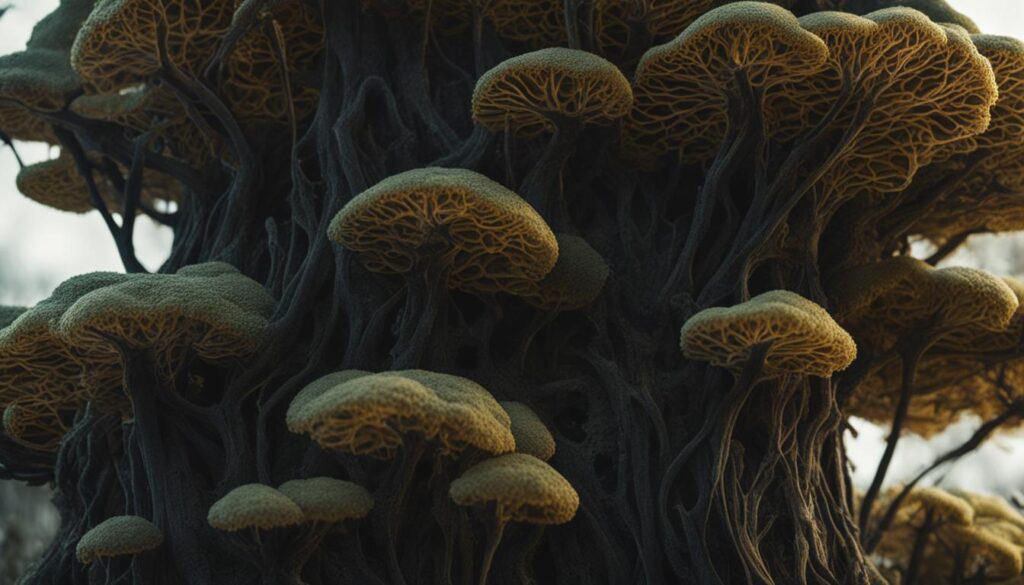
Contamination can be a frustrating setback in mycelium cultivation, but in some cases, it is possible to salvage contaminated mycelium cultures. Swift action and careful handling are crucial in dealing with contaminations to minimize further spread and salvage viable cultures. Here are some steps you can take:
1. Identify and isolate the contamination
First, visually inspect the contaminated mycelium culture and identify the specific type of contamination present. Once identified, isolate the contaminated area by removing the infected tissue or section. This helps prevent further spread of the contamination to the rest of the culture.
2. Strengthen sanitation measures
After removing the contaminated section, it is essential to strengthen sanitation measures to prevent recontamination. Clean and sterilize all tools, equipment, and surfaces thoroughly before handling the culture again. Practice good hygiene by wearing gloves and using disinfectants to minimize the risk of introducing new contaminants.
3. Adjust environmental conditions
Contaminations can sometimes be a result of unfavorable environmental conditions. Review and adjust temperature, humidity, and airflow to create an environment that discourages the growth of contaminants while promoting the growth of healthy mycelium. Consult cultivation guides or experts for specific recommendations based on the type of mycelium you are working with.
4. Treat specific contaminations
Depending on the type of contamination, specific treatments may be available to combat the problem. For example, hydrogen peroxide solutions can be used to control bacterial contaminations, while fungicides can help address fungal contaminations. It is important to research and follow proper treatment protocols to avoid further harm to the mycelium culture.
Remember, not all contaminated mycelium cultures can be salvaged, and it is generally advisable to discard heavily contaminated fruiting boxes to prevent further contamination. However, by taking swift action, implementing stricter sanitation measures, adjusting environmental conditions, and using specific treatments if applicable, you may have a chance of salvaging viable mycelium cultures and minimizing losses.
Table: Comparison of Salvaging Methods for Contaminated Mycelium Cultures
| Contamination Type | Salvaging Method |
|---|---|
| Bacterial contamination | Isolate, strengthen sanitation, adjust environment, treat with hydrogen peroxide solution |
| Fungal contamination | Isolate, strengthen sanitation, adjust environment, treat with fungicide |
| Other types of contamination (e.g., pests, insects) | Isolate, strengthen sanitation, adjust environment, consult experts for specific treatments |
It is important to note that prevention is always better than salvage. By implementing proper contamination control measures, maintaining a sterile environment, and following best practices throughout the cultivation process, you can reduce the risk of contamination and increase the overall success of your mycelium fruiting.
Conclusion
After exploring the factors that contribute to contamination in mycelium cultivation and the impact it can have on fruiting, it is clear that taking safety precautions and implementing contamination control measures are essential for successful mushroom cultivation. Contamination can hinder the growth and quality of mycelium fruit, leading to compromised yields and potential health risks.
To prevent contamination, cultivators should prioritize maintaining a clean and sterile environment, practicing good hygiene, and regularly monitoring for signs of contamination. Adequate sterilization and pasteurization techniques should be employed to create a sterile substrate for mycelium growth. Additionally, starting with reliable primary sources for inoculation can help ensure the purity and consistency of the mycelium used.
Identifying signs of contamination early and promptly addressing them is crucial. Unusual colors, odors, slimy textures, and the presence of molds or bacteria are indicators of contamination. While contaminated fruiting boxes should be discarded, there may be instances where contaminated mycelium cultures can be salvaged through careful handling and specific treatments.
By following best practices and maintaining a vigilant approach to contamination prevention, cultivators can increase the chances of successful mycelium fruiting and produce healthy, high-quality mushrooms.
FAQ
Will contaminated mycelium fruit?
Yes, contamination can have a significant impact on the growth and quality of mycelium fruit. It is important to understand the factors that contribute to contamination and how to prevent it in order to ensure successful mushroom cultivation.
What factors contribute to contamination?
Poor sanitation practices, inadequate sterilization of substrates, exposure to airborne contaminants, and the presence of pests and insects are some of the factors that can contribute to contamination in mushroom cultivation. Proper safety precautions and best practices should be followed to minimize the risk of contamination.
What are the signs of contamination in mycelium?
Unusual colors or odors, slimy or gel-like textures, sectoring or lack of uniform growth, and the presence of molds or bacteria are common indicators of contamination in mycelium. Regular visual inspections and monitoring of growth patterns can help in detecting contamination early and taking necessary steps to prevent its spread.
What is wet spot contamination and how does it affect mycelium growth?
Wet spot contamination, often caused by bacteria such as Bacillus, is characterized by soggy or wet areas in the substrate, the presence of brown or yellowish goo, and stalled or non-growth in certain parts. This type of contamination can have detrimental effects on mycelium growth and fruiting, leading to poor mushroom development and compromised yield.
How can contamination be controlled in mycelium cultivation?
Proper contamination control measures include maintaining a clean and sterile environment, using quality sterilization techniques for substrates, ensuring proper air filtration, practicing good hygiene, and regularly monitoring for signs of contamination. Adhering to these best practices can help minimize the risk of contamination and increase the chances of successful fruiting.
Why are primary sources important for mycelium inoculation?
Starting with agar plates or liquid cultures obtained from reputable suppliers is recommended to ensure the purity and quality of the mycelium used for expansion onto substrates. Using reliable primary sources helps establish a reference library of mycelium and ensures consistent and healthy growth during mushroom cultivation.
How should mycelium be expanded onto different substrates?
The expansion process involves transferring small sectors of fully colonized agar cultures or using liquid cultures to inoculate other substrates such as grains, sawdust, or straw. Understanding and implementing proper expansion procedures, which follow sigmoid-shaped growth patterns, are essential for successful mycelium growth and preventing contamination.
What are the sterilization and pasteurization techniques used in mushroom cultivation?
Sterilization involves killing all microorganisms, while pasteurization reduces the microbial load. Adequate sterilization and pasteurization techniques, including aseptic practices, are important for creating a sterile environment for mycelium growth and minimizing the risk of contamination.
What are the common types of contaminations in mushroom cultivation?
Contaminations can include bacterial, fungal, and pest infestations. Examples of common contaminations include wet spot/sour rot, bacterial blotch, cobweb mold, green mold, black mold, dry bubble, fungus gnats, and mites. Each type of contamination requires specific measures for identification and control to prevent further spread and damage to the mycelium.
Can contaminated fruiting boxes or mycelium cultures be salvaged?
Contaminated fruiting boxes are generally considered a lost cause and should be discarded to prevent further contamination. However, there may be instances where contaminated mycelium cultures can be salvaged by removing infected tissue, implementing stricter sanitation measures, adjusting environmental conditions, and using specific treatments for different types of contaminations. Swift action and careful handling are crucial in dealing with contaminations and salvaging viable mycelium cultures.
How can I ensure healthy and high-quality mycelium fruit?
Understanding the factors that contribute to contamination, implementing proper contamination control measures, and promptly addressing contaminations are essential for ensuring healthy and high-quality mycelium fruit. By following best practices and taking necessary precautions, cultivators can minimize the risk of contamination and increase the chances of successful mushroom cultivation.

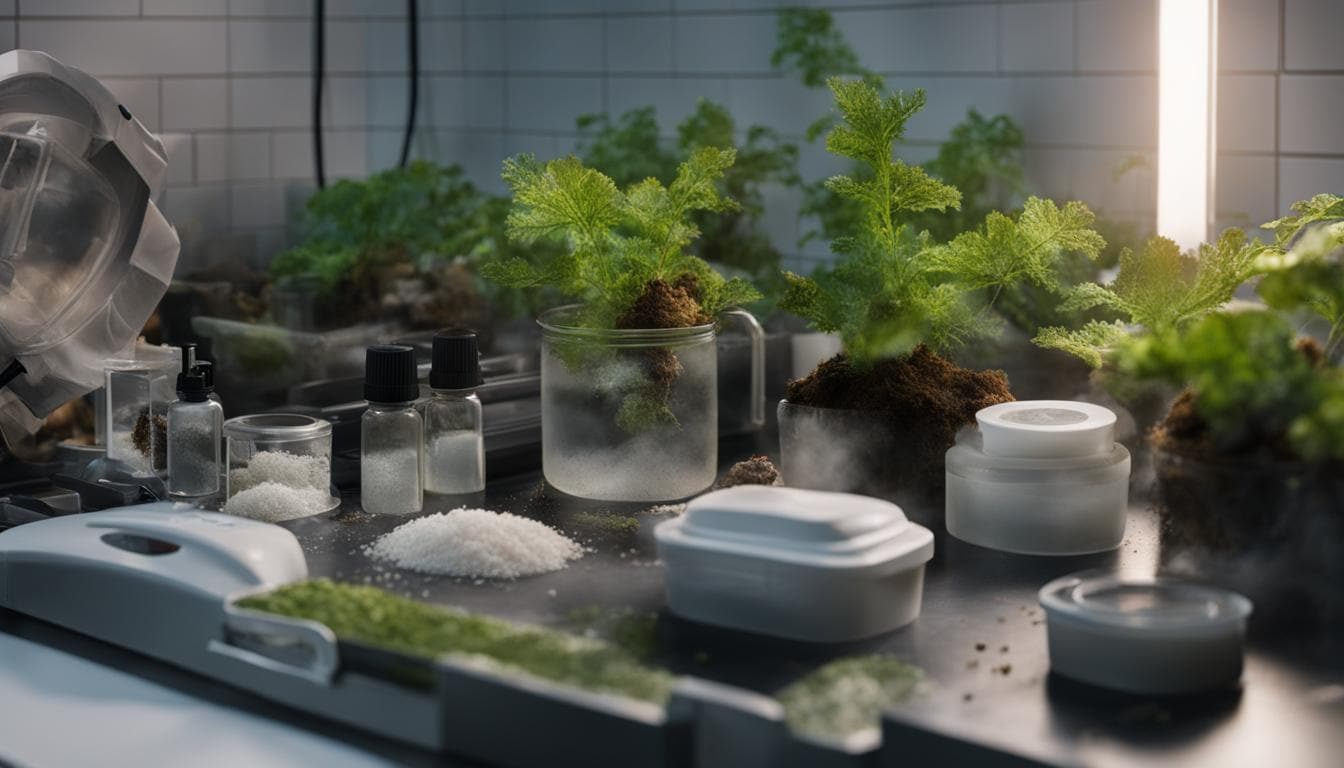



Leave a Reply